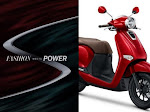Yamaha has recently launched the new Yamaha NMAX Turbo, which is currently available in Indonesia. This model features an electric CVT gearbox, offering improved performance with two riding modes: T-Mode for city use and S-Mode for enhanced acceleration on highways. The NMAX Turbo also includes advanced features like Turbo Y-Shift for customizable acceleration and engine braking, traction control, dual-channel ABS, LED projector headlights, a TFT instrument cluster with navigation, and a smart key for keyless ignition
For standard models, the 2024 NMAX is available with a 155cc engine, producing around 15.4 PS of power and equipped with features such as ABS, traction control, a digital display, and more, targeting a premium feel and enhanced safety for riders
A Yamaha NMAX with a turbo modification is an exciting concept, but it is not a factory option from Yamaha. The Yamaha NMAX is a popular urban scooter that is typically powered by a 155cc single-cylinder engine with Yamaha’s Blue Core technology, which focuses on fuel efficiency and smooth performance.
Key Points About Turbocharging a Yamaha NMAX:
Performance Boost: Adding a turbocharger can significantly increase the engine's horsepower and torque, enhancing acceleration and top speed. However, this modification is quite rare and usually done by custom tuners rather than manufacturers.
Complexity and Costs: Turbocharging a small scooter engine involves adding a turbo kit, which includes a turbocharger, intercooler, custom exhaust, and possibly changes to the engine internals. This process is complex and expensive and requires precise tuning to prevent engine damage.
Reliability and Maintenance: A turbocharged engine generates more heat and stress, which can affect the scooter’s reliability and lifespan. Regular maintenance and careful monitoring are essential to ensure the engine runs safely.
Fuel Consumption: While a turbo can boost performance, it may also increase fuel consumption, depending on how the scooter is ridden.
Legal and Warranty Issues: Turbocharging might void the manufacturer’s warranty and could have legal implications, such as failing to meet emissions regulations or requiring special permits in some regions.
Typical Upgrades for a Turbo NMAX:
- Aftermarket Turbo Kit: Custom kits that include the necessary components for turbocharging.
- Engine Internals: Strengthening components like pistons, connecting rods, and crankshafts to handle the increased power.
- ECU Remapping: Tuning the scooter’s electronic control unit (ECU) to optimize performance with the turbo.
- Cooling System: Upgraded cooling systems to manage the extra heat generated by the turbocharger.
If you are interested in this modification, it’s essential to consult with experienced tuners who specialize in custom scooter modifications. Would you like to know more about the technical aspects or where such modifications can be done?
Turbocharging a Yamaha NMAX offers several advantages, especially for riders seeking enhanced performance and a unique riding experience. Here are the key benefits of a turbocharged Yamaha NMAX:
Keunggulan (Advantages) of a Turbo Yamaha NMAX:
Significant Power Boost: The most obvious advantage of adding a turbocharger is the significant increase in engine power. A turbocharged NMAX can deliver much higher acceleration and top speed compared to the standard version, making it more exciting to ride, especially for those who enjoy spirited riding.
Improved Torque: Turbocharging increases the engine’s torque output, which means the scooter can accelerate faster from a standstill and provide stronger mid-range power. This is especially useful in city traffic, where quick acceleration can enhance maneuverability.
Enhanced Riding Experience: The added power and improved throttle response create a more engaging and thrilling ride. Turbocharged engines deliver a noticeable surge of power, which many riders find exhilarating.
Unique and Custom Look: Turbo modifications often come with aesthetic upgrades, such as custom exhausts, intercoolers, and other visible components that give the NMAX a unique, aggressive look that stands out from standard scooters.
Higher Performance Potential: A turbocharged engine opens the door to further tuning and modifications, such as adjusting boost levels or adding performance parts like upgraded pistons, fuel injectors, and engine management systems. This potential allows enthusiasts to push performance even further.
Better Efficiency Under Certain Conditions: Turbocharged engines can sometimes be more efficient when ridden conservatively because they can extract more energy from each combustion cycle. However, this depends heavily on riding style and tuning.
Bragging Rights: Having a turbocharged NMAX is rare, which provides a sense of exclusivity. It’s a conversation starter at meetups and shows, highlighting the owner’s commitment to performance and customization.
Considerations:
While the benefits are enticing, it’s essential to weigh them against potential downsides, such as increased maintenance, potential reliability issues, and the need for skilled tuning. Turbocharging is best suited for experienced riders who understand the trade-offs and are willing to invest in proper upkeep.
If you’re interested in exploring a turbo modification for your NMAX, consulting with a reputable custom tuner specializing in scooters is highly recommended to ensure a balanced and reliable setup.
Turbocharging a Yamaha NMAX does not typically alter the fuel tank capacity, as the modification mainly affects the engine and related components, not the fuel storage system. The standard fuel tank capacity of a Yamaha NMAX is 7.1 liters.
Impact of Turbocharging on Fuel Consumption:
Increased Fuel Consumption: A turbocharged engine generally consumes more fuel, especially when ridden aggressively, due to the increased power output and the need for more air and fuel in the combustion process.
Range: While the tank capacity remains at 7.1 liters, the riding range per full tank may decrease if the scooter is ridden hard due to the turbo's additional fuel demand.
Riding Style Sensitivity: Efficient riding can still provide reasonable fuel consumption, but aggressive acceleration and high-speed riding will significantly increase fuel use.
If you plan on turbocharging your NMAX, be prepared for these changes in fuel dynamics, and consider this when planning longer rides or daily commutes.







